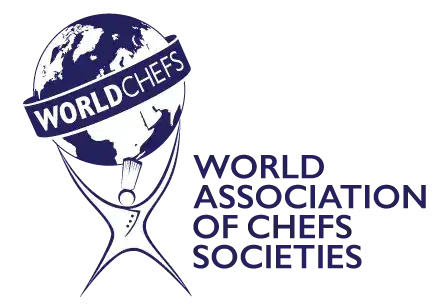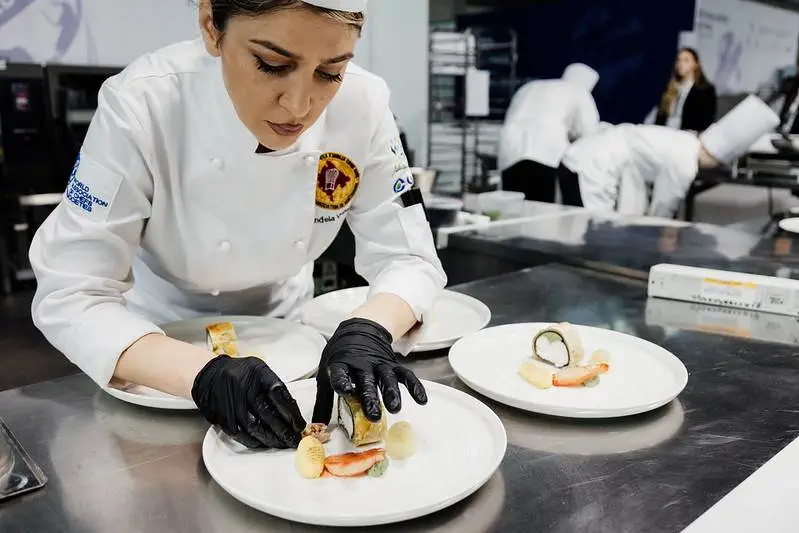At a busy kitchen in Singapore amid serving 40,000 consumers a day, Executive Chef Harish Arya has struck gold. He and his team have reduced food waste in their kitchen by an incredible 95%. For them, it’s both a point of pride and proof that getting creative with ingredients, training staff, and rethinking prep can make a measurable difference.
Stories like this are happening every day in kitchens around the globe. From high-end restaurants to vocational classrooms, chefs are finding smarter ways to work with what they have, reducing food waste, sourcing local, and reconnecting with seasonal ingredients.
Sustainablility asks chefs to make decisions that go beyond the plate. What’s in season? Where did this product come from? How can I use the whole ingredient? What’s the environmental cost of my protein choice? These questions are shaping how chefs cook, and how people eat.
Worldchefs members like Chef Harish offer real-world examples of how chefs are putting a new kitchen standard into practice through sustainable gastronomy.
Let’s go Behind the Pass with them to learn practical steps to create menus that check the boxes for flavor, creativity, sustainability and story.

“Trim – don’t consider it as a waste. It’s a kind of gold. We have to use it. And definitely we’ll have a global impact if you are able to reduce that kind of waste.”
Chef Harish Arya
Understanding Sustainable Gastronomy
What does sustainable gastronomy really mean in today’s kitchens? It’s about building a system that works for the planet, for producers, and for the people we feed. It connects the joy and creativity of cooking with a responsibility to use the power of food for good, protecting our planet’s resources, preserving cultural heritage, and supporting local economies.
According to the FAO:
Gastronomy is sometimes called the art of food. It can also refer to a style of cooking from a particular region. In other words, gastronomy often refers to local food and cuisine. Sustainability is the idea that something (e.g. agriculture, fishing or even preparation of food) is done in a way that is not wasteful of our natural resources and can be continued into the future without being detrimental to our environment or health.
Sustainable gastronomy, therefore, means cuisine that takes into account where the ingredients are from, how the food is grown, and how it gets to our markets and eventually to our plates.
Culinary arts is an art. Caring is an integral part of the craft. By choosing ingredients that are seasonal, locally sourced, and ethically produced, chefs can translate this care into that measurable difference we’re all hoping to make.
From here we’ll dive into how Worldchefs’ industry leaders are making an impact, from zero-waste menu development to experimenting with alternative proteins.

Zero Waste for the Win
At the Sodexo kitchen in Singapore, Chef Manager Harish Arya is working to change mindsets through inventive menu items, pulling from his experience as an award-winning competition chef and inspiration from his mother’s approach to Indian cuisine.
With a focus on repurposing trimmings as valuable ingredients, Chef Harish integrates zero waste principles into routine culinary operations. His team prepares 20 to 30 dishes a day, each an opportunity for a creative spin, including zero-waste soup and shredded watermelon salad.
Deeply influenced by his upbringing in India, Chef Harish’s practices are inspired by the root-to-tip cooking he observed in his mother’s kitchen, and further informed through his experience in culinary competitions.
By using what others might consider waste, Chef Harish creates unique and delicious menu options that celebrate creativity. This everyday ingenuity in the kitchen reflects a broader vision of sustainable gastronomy, one that begins with how we see and use our ingredients.
Chef Harish shares more of his strategies in Episode 125: Making Every Ingredient Count: Leading Zero Waste Efforts with Sodexo Chef Manager Harish Arya, and you can find more ideas in this guide on how to go zero waste.

Ingredient Innovation
At Humber College in Canada, Professor of Culinary Arts Mark Jachecki is helping future chefs discover an unexpected protein that is gaining traction. Working with Jakub Dzamba, Co-Founder and CEO of Third Millennium Farming, he introduces insect protein as a practical solution for the modern kitchen with huge menu development potential in sustainable gastronomy.
Insect protein, derived from sources like crickets and mealworms, is packed with essential nutrients and requires far fewer resources to produce compared to traditional animal proteins. Insect protein can be used in a wide range of dishes, offering new textures and flavors to experiment with while reducing environmental impact.
These ingredients are already making their way into classrooms and kitchens, helping to shift perceptions and broaden ingredient choices. As part of Worldchefs’ Feed the Planet webcast series, Mark and Jakub shared insights on how chefs can help mainstream insect protein, such as cricket flour in pasta or high-protein snack bites, that are both novel and nutritious.
By exploring sustainable protein alternatives like insect protein, chefs can play with taste, versatility, and push the boundaries of what’s possible on the plate, for the palate and the planet.
Catch their conversation on Sustainability Around the World #48: Insect Protein for Chefs: The Next Frontier in Sustainable Cuisine.
Culinary Heritage for the Future
In the hills of southern Italy, Ristolab is future-proofing the Mediterranean diet by looking both to the past and to the future. Led by Chef Amabile Cortiglia and food scientist Dr. Sofia Cavalleri, this unique culinary research lab and restaurant blends scientific and traditional knowledge to craft menus that promote sustainability, health, and culture.
Their approach uses food experience to protect biodiversity by using local, seasonal, and wild ingredients, many of which have been part of regional diets for centuries. By studying traditional farming methods and food preservation techniques, and pairing them with nutritional research, they create climate-friendly menus that shine a light on a budding future of eco-conscious dining and sustainable tourism.
For Chef Amabile and Dr. Cavalleri, preserving culinary heritage honors the past and applies it to today’s challenges. Through their menus, they show how heritage cuisine can guide the future of sustainable gastronomy.
You can hear more from them on Sustainability Around the World #45: Ristolab, Where Science Meets Sustainable Gastronomy and find more on this topic in our recent article, Preserving the Past, Cooking for the Future: How Heritage Cuisine Nourishes Culture, Health, and Innovation.
Local, Seasonal, Smart: A New Kitchen Standard
From whole ingredient cooking to inspiration from generations past, these examples illustrate how much there is to explore when it comes to sustainability. It’s both a responsibility and an exciting lens that challenges us to get curious and creative.
How will you apply an understanding of sustainable gastronomy to your cuisine?
Next Steps for Chefs: Sustainable Gastronomy
For Chefs & Organizations:
- Celebrate Sustainable Gastronomy Day on 18 June by signing for Sustainability Education for Culinary Professionals, a free, open-source course available in eight languages on Worldchefs Academy. Get certified in culinary sustainability and drive sustainable change in your daily life. You’ll gain a digital badge to promote your new knowledge and skills.
- Watch our UN Oceans Conference side event webcast, Sustainably Sourced: Science & Seafood.
- Register for the upcoming Art&Science webinar From Waste to Wonder.
- Become a Sustainability Education for Culinary Professionals Approved Trainer and join our global network of sustainability experts. At the end of training, you’ll receive the trainer digital badge and certificate from Worldchefs and be able to teach the curriculum to your school, association or workplace.
Learn more about Worldchefs’ sustainability initiatives at feedtheplanet.worldchefs.org.















































